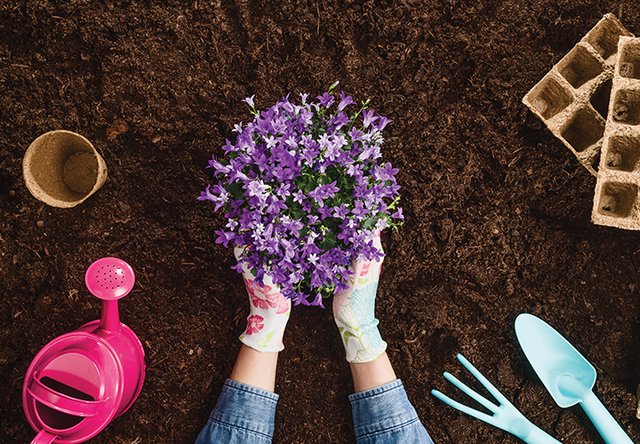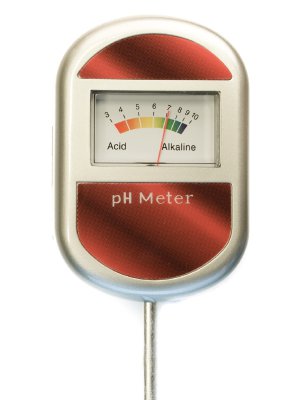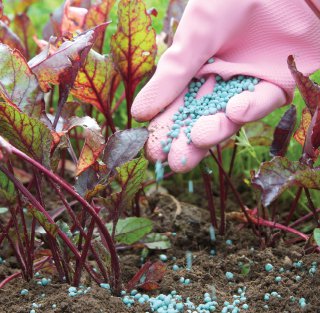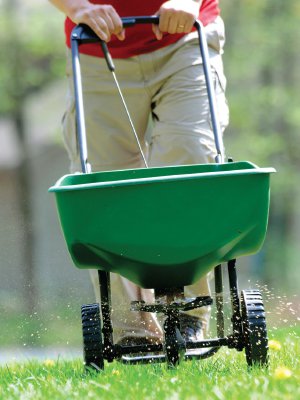Watching Your Garden’s Diet: Choosing the right nourishment for plants

Properly feeding our loved ones – human, fauna, and flora, is a responsibility we do not take lightly. We feed our families, our friends, our pets, our neighbors, even strangers, and we must not forget to feed our gardens and lawns too. Summer is almost in full swing, with all its beauty and pleasures. As we look over our flourishing gardens, all our efforts— the planning and the investment of time and money— seem worthwhile. The azaleas are still providing some ruffled blooms, the boxwood is leafy, and the roses are showing off their petaled heads. White and yellow daisies, pink and red petunias, yellow coreopsis and purple sage—all are dazzling us with their showy blooms. The lawn is lush and sparkling green. Time now to drink in the splendor.
Ah, but there may be a little nagging voice in the back of your mind, “Do I need to add more protein to the kids’ diet? Is the dog gaining weight? What should we grill for the neighborhood picnic? Aren’t the lilies looking a bit droopy?” And the list goes on.
So, I’m here to help—at least with the flora portion of your grownup list of responsibilities. Whether you hire garden specialists or care for your garden yourself, it’s time to think about a well-balanced diet for your garden. As with vitamin supplements and fortified foods, finding the right nutrients, aka fertilizer, and appropriate application schedule for your garden is important and a bit complicated. But, once you’ve figured out what needs to be done to keep your garden well fed and healthy, you will continue to enjoy your garden’s beauty until the last blossoms have fallen.
Gardener David Culp’s admonishment to “do the least harm and the most good” in our gardens is particularly pertinent when it pertains to fertilizing in our region. In our backyards and neighborhoods, marshes, streams, creeks, and rivers flow into one of the most beautiful and prolific estuaries in the world: the Chesapeake Bay. As we know only too well, run-off from our gardens pollutes the waters of the Bay. But, if we educate ourselves to the needs of our individual gardens, we can do something about that pollution. We can stem the flow of excess nitrogen, phosphates, and other nutrients and chemicals into the Bay. We can make sure that, like our children, our plants, shrubs, and trees are getting exactly the nutrients they need to flourish.
PREP WORK: First, test your soil—or ask your gardener about the current condition of your soil. You want to know the pH or soil acidity. That information is vital, and the test results may vary from your last test’s results, so be sure to use test results calculated within the last growing cycle, or last six months. Your gardener will be able to perform the soil test quickly. Or, you can order a test kit online, and test the soil yourself. In either case, the testing is inexpensive and easily accomplished.
One of the most important measurements of your soil is the nitrogen level of the soil; it’s measured on a ten-point scale. Nitrogen supports photosynthesis and leads to healthy, lush foliage and flower production. On the ten-point scare, 7.0 is neutral. 8 or above is less acidic; 6 and below is alkaline or more acidic. Your flowers probably prefer a bit on the alkaline side, 6.3 or so. For quick remedies, ground limestone can be added to your soil to increase ph. Sulfur or aluminum sulfate can be added to lower your soil’s pH level. But a caution: It may take six to nine months for these substances to change your pH level.
MENU PLANNING: Once you’ve performed any triage your garden soil might have needed, you can make a plan for maintaining healthy nutrient levels in your garden and among your shrubs and trees. This is where careful attention to detail, at least at the outset, is vital to protecting both the Bay’s estuary system and your garden’s health. Overly enthusiastic fertilizing, by your gardener or by you, will not provide lovelier, stronger garden growth. To the contrary, over-fertilizing can burn your plants’ roots and disrupt the pH balance in the soil. In addition, the excess nitrogen, phosphate, and potassium could filter through the soil and into the water table. From there, they become pollutants feeding algae blooms and choking the oxygen from the water.
INGREDIENTS: If you’re looking at fertilizers that come prepackaged, you’ll probably see three numbers on the label; these numbers indicate the fertilizer’s nutrient ratios. For example, 5-10-5. The first number indicates the percentage of Nitrogen in the fertilizer. The second number is the percentage of Phosphorous, and the third number is the percentage of potash or potassium. A 5-10-5 ratio is considered a “complete fertilizer.” The nutrients contained in fertilizer each provide support for a particular plant process:
- Nitrogen encourages new growth.
- Phosphorous builds the root system and encourages the production of buds, flowers, fruit and seeds.
- Potassium protects a plant from disease.
- Calcium binds the soil so it properly supports the plant’s root system.
- Magnesium encourages photosynthesis.
- Sulfur protects plant protein.
Based on the general health and quality of your garden’s soil and plants, you can look for fertilizers that provide the nutrients you need.
The consensus seems to be that fertilizing is best done every six to eight weeks. That means if you fertilized in the spring, early May perhaps, you can fertilize again now, as the summer gets underway, and in late August or early September. The exception to that rule is after a period of heavy or prolonged rain, which will wash away the nutrients you’ve put there. After a rainy period, a “snack” of well-rounded, water-soluble fertilizer may be necessary. Also, if you replace plants, it’s a good idea to add some fertilizer to the soil in which the new plant will grow, and some fertilizer along with the bulbs when you plant bulbs.
FERTILIZER TYPES: So, which will it be? An organic or chemical fertilizer? Organic fertilizers include animal and green manure (leaves and other undecomposed plant products), blood meal, fish emulsion, cottonseed meal, granite dust, and rock phosphates. Chemical fertilizers are marketed in liquid, granular, powder, and pellets forms.
ADVANTAGES: Organic fertilizers contribute organic matter to the soil, improving your soil’s structure. Such natural fertilization provides a steady diet of nutrients to the soil and helps your plants fight fungal and bacterial disease. Chemical fertilizers are man-made and may include sodium nitrate, potassium chloride, and superphosphates. They are often cheaper per square foot than organic fertilizer, and chemical fertilizers are fast-acting, breaking down and being absorbed almost immediately.
DISADVANTAGES: Organic fertilizers have some drawbacks. They are usually bulky and difficult to transport and store; consider a bag of chicken manure or a wheelbarrow full of leaves, carrots, and potatoes breaking down in a corner of your backyard. Because organic matter breaks down slowly, it’s an unreliable resource if your plants need food now. Additionally, organic fertilizers are fugitive; they are inconsistent in makeup and do not retain their nutrient composition.

Chemical fertilizers have their problems too. They don’t improve the soil’s structure or add organic matter to the soil. Some chemical fertilizers can actually harm microorganisms, interfering with long-term plant growth. Finally, producing chemical fertilizers requires lots of energy; there’s a big carbon footprint.
As with the food we feed our bodies, what we feed our plants matters. But sometimes we must weigh convenience versus nutrition, which often leads to a compromise—providing the best nutrition within the limits of our time and resources. So, we add a green salad to that kids’ mac and cheese Saturday lunch. Or, we purchase the vegetable medley ready-made instead of preparing our own chopped and marinated carrots and cucumbers.
And that may be the same compromise we make in our gardens. Give your plants and the soil that nourishes them a healthy dose of organic fertilizer now, as summer begins. As the weeks pass and your garden delights you, you may see a drooping plant or a tired shrub. Give those dears a short-term boost of chemical fertilizer. Hopefully, they’ll perk right up and thank you with more showy blooms.
A word of caution: If you’ve turned over the fertilizing responsibilities to your gardener, avoid doing your own fertilizing between the gardener’s visits. Or, be sure to check with your gardener if you feel compelled to do auxiliary feeding. Over-fertilizing can cause serious damage to your plants. More is not better. And, if you’re doing your own fertilizing, moderation is advisable. Trust your plants to let you know if they need extra nourishment. If they’re doing well, just relax and rely on the fertilization schedule you’ve devised.
As with all our grownup responsibilities; make a plan, implement your plan, and be prepared to intervene and be flexible if problems arise. The family may need a multivitamin to keep up with the busy summer schedule, the dogs may get a few healthy treats not on their diet, and you may figure out some well-balanced snacks to serve up at a last-minute party. And, in the garden, you may do the same, for your plants—plan for the garden’s fertilization, but be willing to provide supplemental nutrition if heavy rains wash out the fertilizer or a few plants need some extra nourishment. Keep on hand a little liquid seaweed or household fertilizer from the hardware store, just in case. Then, lean back and watch your garden flourish.




Loved the article especially the explanation of the numbers. I always wondered but not enough to question. Me, I leave those decisions to my gardener. He’s really been slipping lately. I’m going to print this article and hand it to him. Love, Nancy
—————————————–